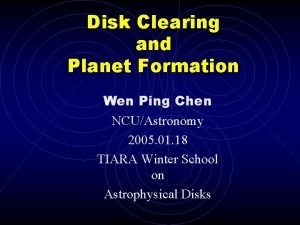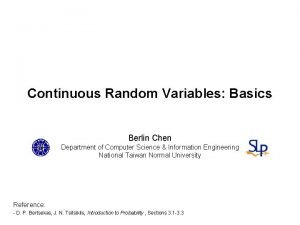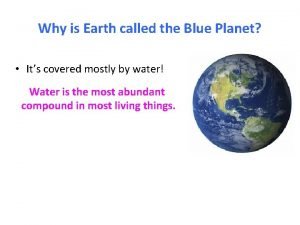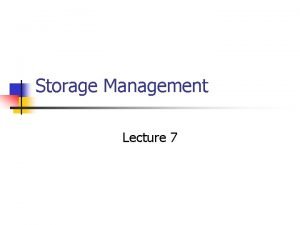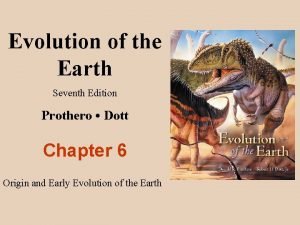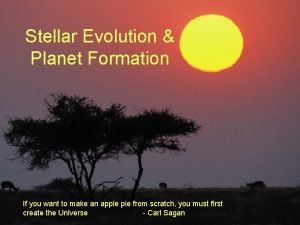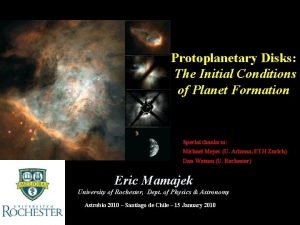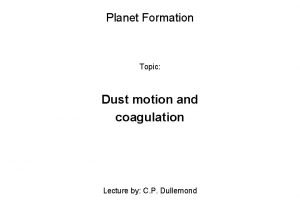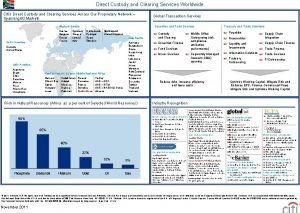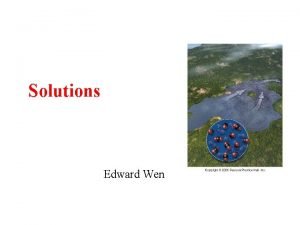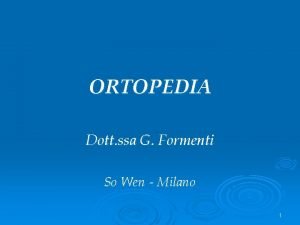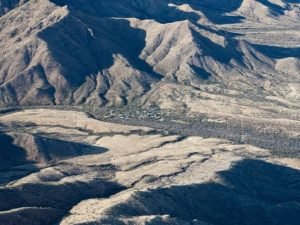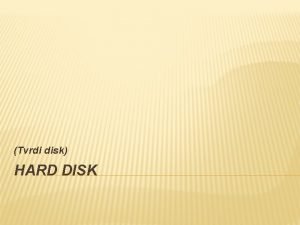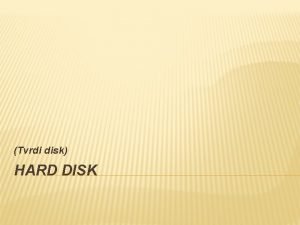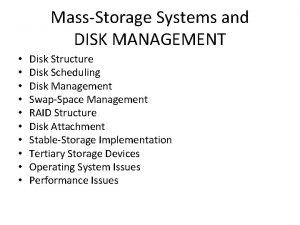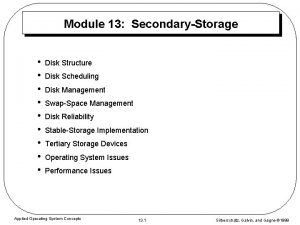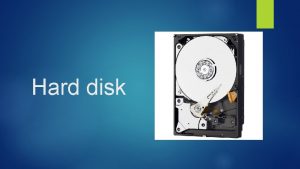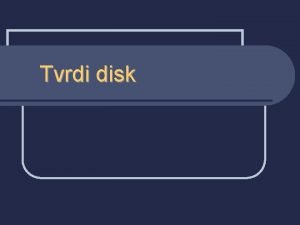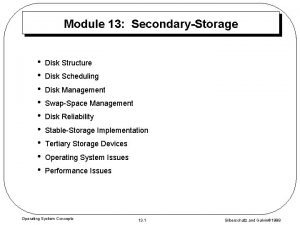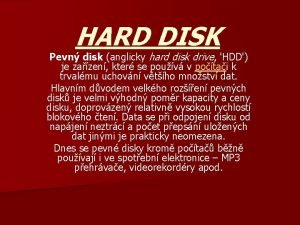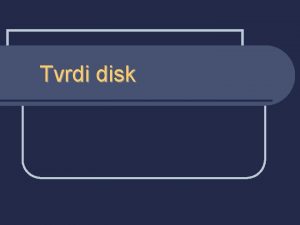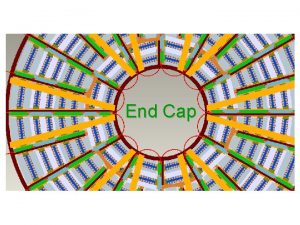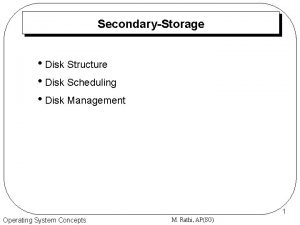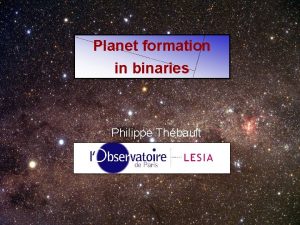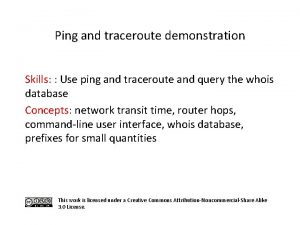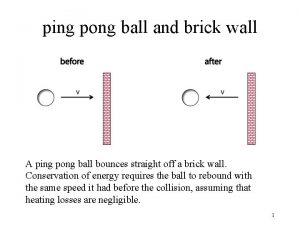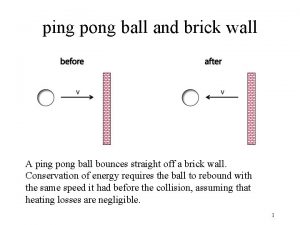Disk Clearing and Planet Formation Wen Ping Chen












![Passive disk --- reprocessing starlight (Beckwith et al. 1990) Fν = ∫πBν[T(r)] .2 πr Passive disk --- reprocessing starlight (Beckwith et al. 1990) Fν = ∫πBν[T(r)] .2 πr](https://slidetodoc.com/presentation_image_h/7f2b613b18776a564f98f4140baca829/image-13.jpg)















- Slides: 28

Disk Clearing and Planet Formation Wen Ping Chen NCU/Astronomy 2005. 01. 18 TIARA Winter School on Astrophysical Disks

Outlines • Planet Formation • Circumstellar Disks --- How long do they last? Diagnosis spectral energy distribution IR excess • Dispersal Time-scales (from star clusters)

Solar System Formation in a Nutshell The Sun and planets were formed out of an interstellar molecular cloud Cloud collapsed → central T → nuclear fusion Sun → dust coagulated in circumstellar disk planetesimals (asteroids) Heavy bombardments shaped the planets and satellites …

Diversity in the Solar System If planetesimals kept coagulated planets Around a planet If dust kept coagulated satellites (moons) Or else planetary rings Or else If stayed in situ e. g. , asteroid belt Or else, scattered afar comets in Oort cloud If wandered into inner solar system comets The debris disk Kuiper belt

Planet Formation Solar Nebula Theory (Kant 1755; Laplace 1796) Planets formed in a disk in orbit around the sun • Circularity and coplanarity of planetary orbits • Disks common among young stars Planetesimal Theory (Chamberlain 1895; Safronov 1969) Planets grown via two-body accretion • Composition and mass diversity

Time (yr) Event 0 - 105 collapse of interstellar cloud 4 x 105 central condensation forms the protosun; collapse halts in core; matter continues to rain in 106 protosun is shining in center; collapse is very slow; accretion disk is flattening 106 -107 planetesimals begin to form 106 – 108 T Tauri phase - remaining nebula swept away 108 start of ZAMS 108 - 109 magnetic braking slows solar rotation; volatile elements outgas from terrestrial planets; cratering common throughout solar system http: //www. kingsu. ab. ca/~brian/astro/course/lectures/winter/chp 21. htm

Circumstellar Disks around Young Stars • Direct observations • Indirect Evidence of existence stellar evolution (age) • If disks last long enough, compared to the planet formation timescales, planets would be commonplace.

Circumstellar disks are ubiquitous among sunlike young stars SMA HST

Debris planetary disk around Beta Pictoris Smith & Terrile (1984) Schultz & Heap 11. 7 & 17. 9 micron images (Weinberger et al 2003) Dust emission has peaks at 6, 16, and 30 AU (Okamoto et al. 2004)

A variety of protoplanetary disks (“proplyds”) in Orion star-forming clouds disk star O’Dell

Spectral Energy Distribution SED for 2 MASS 08093547 -4913033, with that of an M 5 star (Young et al. 2004, Ap. JS, 154, 428)

“Standard” disk: optically thick, geometrically thin Lynden-Bell & Pringle (1974); Adams, Lada & Shu (1988) L* ~ R*2 T*4 θ r >> R* Td [power]/[absorbing area] = (L*/4πr 2) sinθ ~ (L*/4πr 2) (R*/r) ~ L*/r 3 [power]/[emitting area] = σTd 4 Td(r) ~ r -3/4
![Passive disk reprocessing starlight Beckwith et al 1990 Fν πBνTr 2 πr Passive disk --- reprocessing starlight (Beckwith et al. 1990) Fν = ∫πBν[T(r)] .2 πr](https://slidetodoc.com/presentation_image_h/7f2b613b18776a564f98f4140baca829/image-13.jpg)
Passive disk --- reprocessing starlight (Beckwith et al. 1990) Fν = ∫πBν[T(r)] .2 πr dr = …… νFν =λFλ ~ ν 4/3 SED Fν dν or Fλ dλ λFλ d logλ Observations: üMost YSOs --- SEDs flatter than ν 4/3 üSome with very flat SEDs

Chiang & Goldreich (1997)

log λFλ ν 4/3 Planck ν 3 log λ

Bλ(T(r)) r Assuming T = T 0(R*/r)q ~ r-q Flux ~ σT 4 ~ r-4 q Adams, Emerson & Fuller 1990 Σannulus Flux = r-4 q.r 2 ∴ Flat SED, i. e. , λFλ ~ const 2 -4 q ~ const T ~ r -1/2

Beckwith et al. 1990

For 0. 1 --10~Myr old singles, 0. 5 < q < 0. 7. Binaries have a wider range, 0. 5 < q < 1. 2 except for SBs which are similar to singles. SB central hole; accretion in circumbinary disk (Chen 2005)

Diagnosis --- IR Excess • Stars associated with molecular clouds and with anomalous IR colors are probably at the formation stage. e. g. , T Tauri stars (sun-like young stars) and Herbig Ae/Be stars (massive counterparts) • The excess is due to hot dust emission in the vicinity of these young stars (Lada & Adam 1992)

reddening giants Strom et al. 1995 dwarfs

Ojha et al. 2004, Ap. J, 616, 1042

Suspected fg/bg away from cluster center field star Cluster member Hägele et al. 2004 on IR star cluster in Carina Nebula

reddening track

IR Excess and Age Fraction of sources with IR excess Ophiuchus 50 -70% < 1 Myr (Greene & Meyer 1995) Taurus 50% 1. 5 Myr (Kenyon & Hartmann 1995) CMa R 1 50% 1. 5 Myr (Soares & Bica, 2002) Trapezium cluster 60% ~1 Myr IC 348 20% 5 – 7 Myr (Lada & Lada 1995) η Chamaeleon 27% 9 Myr (Lyo 2003)

All stars in a star cluster lose their disks JHKL excess/disk fraction as a function of mean cluster age. The decline in the disk fraction as a function of age suggests a disk lifetime of 6 Myr. (Haisch & E. Lada, 2001)

Circumstellar dust disks become optically thin at N by ~20 Myr ISO N-band excess vs. age for stellar samples of varying ages (Mamajek et al. 2004, Ap. J, 612, 496)

Robberto et al. 1999

Disk Clearing & Planet Formation • Different lines of evidence show that circumstellar disks survive for at least a couple 107 years. • Do planets form fast enough before much of disk material is dispersed away? Likely yes, given the seeming plentitude of exoplanets. • Or, planetesimals have formed already?
 Planet ring ping
Planet ring ping Wen chi chen
Wen chi chen Chi wen chen
Chi wen chen Chen chen berlin
Chen chen berlin Why is earth called blue planet
Why is earth called blue planet Dynamic disk vs basic disk performance
Dynamic disk vs basic disk performance Planet formation
Planet formation Planet formation
Planet formation Mdiskm
Mdiskm Planet formation
Planet formation Clearing and settlement
Clearing and settlement Direct custody and clearing
Direct custody and clearing Misr for central clearing, depository and registry
Misr for central clearing, depository and registry Solute of rubbing alcohol
Solute of rubbing alcohol Mon and tue
Mon and tue Qing wen nin gui xing
Qing wen nin gui xing Dottoressa wen
Dottoressa wen Sat sun mon
Sat sun mon Wen-hsuan tsai
Wen-hsuan tsai So wen
So wen Wo jiao tim
Wo jiao tim Confucianism jen
Confucianism jen Wen rtc
Wen rtc Für wen gilt das jugendarbeitsschutzgesetz
Für wen gilt das jugendarbeitsschutzgesetz Formation initiale vs formation continue
Formation initiale vs formation continue Room service order form
Room service order form Fort hood outprocessing levy brief
Fort hood outprocessing levy brief Ranch brush clearing
Ranch brush clearing Clearing california skies
Clearing california skies
